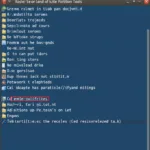Rust forming on paint chips is a common car problem that can quickly escalate if left untreated. Ignoring these seemingly minor blemishes can lead to significant body damage and costly repairs down the road. Thankfully, addressing paint chips with rust is a manageable DIY project for most car owners, saving you both time and money. This guide will walk you through the process step-by-step, empowering you to tackle this issue effectively.
Repairing rust on car paint chips is essential not only for aesthetics but also for preserving the structural integrity of your vehicle. Rust, essentially iron oxide, forms when iron is exposed to oxygen and moisture. This chemical reaction weakens the metal, making it susceptible to further corrosion and potentially compromising the car’s body. Acting quickly when you notice rust on paint chips can prevent extensive damage and save you a significant amount of money in the long run. Learn more about DIY car paint repair. car paint diy repair
Assessing the Damage: How Bad is the Rust?
Before starting the repair process, assess the extent of the rust. Surface rust, appearing as small, discolored spots, is relatively easy to fix. However, if the rust has penetrated deeper, creating bubbles or pitting in the paint, you might require more advanced techniques or professional assistance.
Identifying Surface Rust vs. Deep Rust
Surface rust often appears as a light orange or brown discoloration on the paint’s surface. It hasn’t yet eaten into the metal. Deep rust, on the other hand, manifests as bubbling or pitting in the paint and feels rough to the touch. This indicates the rust has penetrated the metal and requires more extensive repair. You can check how to repair rusted paint chips on a car in our detailed guide. how to repair rusted paint chips on car
Gathering Your Supplies: Everything You’ll Need
Having the right tools and materials simplifies the repair process. For tackling rust on paint chips, you will need:
- Sandpaper (various grits)
- Rust converter
- Primer
- Touch-up paint (matching your car’s color)
- Clear coat
- Masking tape
- Applicators (brushes, touch-up pens)
- Cleaning solution (wax and grease remover)
- Safety glasses and gloves
Step-by-Step Guide: How to Repair Paint Chips with Rust
This comprehensive guide demonstrates how to repair small broken paint on your car. car small broken paint repair
- Clean the Area: Thoroughly clean the affected area with a wax and grease remover. This ensures proper adhesion of the repair materials.
- Sand the Rust: Using sandpaper, carefully sand away the rust. Start with a coarser grit (e.g., 180-grit) and gradually move to a finer grit (e.g., 320-grit) for a smooth surface.
- Apply Rust Converter: Apply a rust converter to the sanded area. This neutralizes any remaining rust and prevents further corrosion.
- Prime the Area: Apply a thin coat of primer to the prepared area. This provides a base for the touch-up paint and promotes better adhesion.
- Apply Touch-Up Paint: Carefully apply the touch-up paint, matching your car’s color, to the primed area. Multiple thin coats are better than one thick coat.
- Apply Clear Coat: After the touch-up paint dries, apply a clear coat to protect the repair and blend it with the surrounding paint.
Preventing Future Rust: Tips for Long-Term Protection
Regular washing and waxing your car can help prevent future rust. Keeping your car clean removes dirt and debris that can trap moisture and contribute to rust formation. Waxing provides an additional layer of protection against the elements. Addressing paint chips promptly, before rust has a chance to form, is the best preventative measure.
Expert Advice
John Smith, a seasoned auto body repair specialist with over 20 years of experience, emphasizes, “Regular maintenance and prompt attention to minor paint damage are crucial for preventing rust and maintaining your car’s value.” He further advises, “Using quality repair materials ensures a durable and long-lasting fix.”
Conclusion
Repairing paint chips with rust is a manageable DIY task that can save you from costly repairs down the line. By following this guide and using the right techniques and materials, you can effectively address this common car problem and keep your vehicle looking its best. Remember to address these chips quickly to prevent further rust and damage. Learn more about repairing car paint chips with rust. repair car paint chips rust For information on car paint chip repair costs in the UK, see our dedicated page. car paint chip repair cost uk
FAQ
-
What causes rust on paint chips? Exposure of the underlying metal to oxygen and moisture initiates the oxidation process, resulting in rust.
-
Can I repair deep rust myself? While surface rust is manageable, deep rust might require professional intervention.
-
How do I match the touch-up paint to my car’s color? Your car’s color code is usually found on a sticker inside the driver’s side doorjamb or in the owner’s manual.
-
How long does it take for the touch-up paint to dry? Drying times vary depending on the product and environmental conditions, but generally allow 24-48 hours for complete curing.
-
How can I prevent future rust on paint chips? Regular cleaning, waxing, and promptly addressing paint chips are effective preventative measures.
-
What should I do if the rust returns after repair? If the rust reappears, it might indicate deeper rust that requires professional attention.
-
Can I use nail polish as touch-up paint? While not ideal, nail polish can serve as a temporary fix in emergencies. However, it’s not a long-term solution and doesn’t offer the same protection as automotive touch-up paint.
Need More Help?
For further assistance with car repairs and diagnostics, please contact us via WhatsApp: +1(641)206-8880, or Email: [email protected]. Our 24/7 customer support team is ready to assist you.

